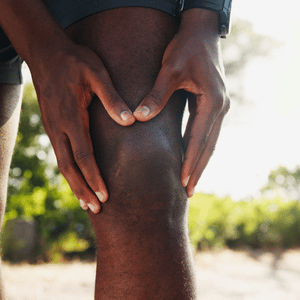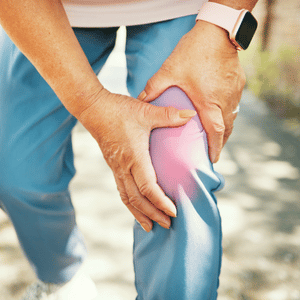Knee pain is a common complaint, whether you’re an avid runner tackling the trails or simply navigating the everyday hustle. That familiar ache, sharp stab, or persistent stiffness can significantly impact your mobility and quality of life. As chiropractors in Pretoria, we see many individuals seeking relief from knee discomfort. To better understand what might be causing your pain, let’s delve into some frequent culprits: iliotibial (IT) band tendinopathy, meniscus tears, knee ligament sprains/tears, and chondromalacia patella (also known as Runner’s Knee).
Understanding these conditions, their symptoms, and what to expect during a chiropractic assessment and treatment can empower you on your journey to recovery.
The Culprits Behind Your Knee Pain:
1. Iliotibial (IT) Band Tendinopathy: The Outer Knee Agony
The iliotibial (IT) band is a thick band of connective tissue running along the outside of your thigh from your hip to just below your knee. When this band becomes tight, inflamed, or irritated where it crosses the bony prominence of the outer knee (lateral femoral epicondyle), it can lead to IT band tendinopathy.
Symptoms May Include:
- Gradual onset of pain on the outside of the knee, often worsening with activity, particularly running, cycling, or hiking.
- As you continue the activity, the initial ache may become a sharper, more intense pain
- Pain may be worse with uphill running, and ascending/descending stairs
- Pain that may start after a certain distance or duration of activity.
- Tenderness when pressing on the outside of the knee.
- Pain that may ease with rest but returns with activity.
- Possible reporting of tightness in the outer thigh or hip.
What to Expect in a Chiropractic Physical Examination:
-
- Observation: Assessing your posture and gait for any biomechanical imbalances.
- Palpation: Gently feeling the IT band along your thigh and the lateral aspect of your knee to identify areas of tenderness and tightness.
- Range of Motion Assessment: Checking how far you can bend, straighten, and rotate your knee and hip.
- Specific Orthopaedic Tests
Chiropractic Treatment May Include:
-
-
- Soft Tissue Therapy: Techniques such as myofascial release and trigger point therapy to address IT band tightness and surrounding muscle imbalances.
- Joint Manipulation & Mobilization: Restoring proper movement in the spine, hip, knee, and ankle joints if restrictions are found.
- Therapeutic Exercises: Prescribing stretches to improve IT band flexibility and exercises to strengthen the hip abductor muscles (like the gluteus medius) which help stabilize the pelvis and reduce strain on the IT band.
- Postural and Biomechanical Advice: Guidance on proper form during activities and addressing any underlying postural issues.
-
2. Meniscus Tear: The Twisting Trauma
The menisci are C-shaped pieces of cartilage that act as shock absorbers between your thighbone (femur) and shinbone (tibia). A meniscus tear often occurs due to a twisting or pivoting motion of the knee, especially when weight-bearing. It can also happen gradually due to wear and tear over time.
Symptoms May Include:
-
-
- Often a specific incident of twisting or trauma to the knee might be recalled.
- Sudden onset of pain in the knee, often localized to the inside (medial) or outside (lateral) of the joint line.
- Popping or clicking sensation at the time of injury or with movement.
- Swelling typically appears later or not at all; immediate swelling is rare; if it happens, it may be indicative of a ligament injury.
- Stiffness and difficulty fully straightening or bending the knee.
- Locking or catching sensation in the knee, where it feels stuck.
- Pain that may worsen with weight-bearing activities or twisting movements.
-
What to Expect in a Chiropractic Physical Examination:
- Observation: Looking for swelling, bruising, or any visible deformity.
- Palpation: Assessing for tenderness along the joint line where the meniscus is located.
- Range of Motion Assessment: Evaluating the degree and quality of knee movement, noting any pain or restriction.
- Specific Orthopaedic Tests
Chiropractic Treatment May Include:
- Joint Mobilization: Gently restoring proper movement in the knee, hip, and ankle to improve overall biomechanics.
- Soft Tissue Therapy: Addressing any muscle spasms or tightness around the knee and hip.
- Therapeutic Exercises: Prescribing exercises to strengthen the muscles surrounding the knee (quadriceps, hamstrings, calves) to provide stability and support.
- Activity Modification Advice: Guidance on avoiding activities that aggravate the pain and promote healing.
- Referral: In cases of significant tears or persistent symptoms, referral for further imaging may be necessary.
3. Knee Ligament Sprains: The Stability Strain
The knee joint is stabilized by several ligaments, including the lateral (LCL) and medial collateral ligament (MCL), as well as the anterior (ACL) and posterior cruciate ligament (PCL). A ligament sprain occurs when these ligaments are stretched or torn, often due to a sudden force, twisting injury, or direct blow to the knee.
Symptoms May Include:
- Often a specific traumatic event is recalled, such as a sudden twist, fall, or direct impact to the knee during sports or an accident.
- Immediate pain at the time of injury, which can be severe.
- A popping or tearing sensation may be reported, particularly with ACL injuries.
- Rapid swelling around the knee, often developing within minutes to hours.
- Difficulty bearing weight on the injured leg.
- A feeling of instability or giving way in the knee.
- Pain and tenderness when pressing on the injured ligament.
What to Expect in a Chiropractic Physical Examination:
- Observation: Looking for significant swelling, bruising, or any obvious deformity.
- Palpation: Carefully assessing for tenderness along the course of the specific ligaments.
- Range of Motion Assessment: Gently evaluating knee movement, noting pain and any limitations.
- Specific Orthopaedic Tests
Chiropractic Treatment May Include:
- Pain and Inflammation Management: Initially focusing on reducing pain and swelling through modalities like ice and rest.
- Gentle Joint Mobilization: Once pain and swelling subside, gentle mobilization techniques may be used to restore proper knee joint mechanics.
- Joint Manipulation: Manipulation of the sacro-iliac joints, spine, hip and foot to address compensatory changes.
- Soft Tissue Therapy: Addressing any muscle guarding or spasms around the knee.
- Progressive Rehabilitation Exercises: A tailored exercise program to gradually restore range of motion, strength, balance, and proprioception (awareness of joint position).
- Kinesiology Taping
- Referral: Depending on the severity of the sprain, referral for further imaging may be necessary.
4. Chondromalacia Patella: The Runner’s (and Sitter’s) Knee
Chondromalacia patella, also known as patellofemoral pain syndrome or “runner’s knee,” is a condition where the cartilage underneath the kneecap (patella) softens and breaks down. This can occur due to repetitive stress, muscle imbalances, improper patellar tracking (movement of the kneecap as the knee straightens and bends), or direct trauma. Despite the name, it can affect individuals who aren’t runners too, particularly those with prolonged sitting or activities involving repetitive knee bending.
Symptoms May Include:
- Gradual onset of dull, aching pain at the front of the knee, often around or behind the kneecap.
- Pain that is often worse with activities like squatting, kneeling, going up or down stairs, running, or prolonged sitting with bent knees (“movie-goer’s knee”).
- A possible grinding, clicking, or popping sensation when moving the knee.
- A feeling of weakness or giving way in the knee.
- Pain that may be relieved by straightening the leg.
What to Expect in a Chiropractic Physical Examination:
- Observation: Assessing the alignment of your legs and knees, looking for any signs of muscle imbalances.
- Palpation: Gently pressing on the kneecap to assess for tenderness and evaluating the tracking of the patella as you bend and straighten your knee.
- Range of Motion Assessment: Checking the movement of your knee and hip.
- Specific Orthopaedic Tests
Chiropractic Treatment May Include:
- Joint Manipulation & Mobilization: Addressing any restrictions in the knee, hip, and ankle that may be contributing to improper patellar tracking.
- Soft Tissue Therapy: Releasing tightness in the quadriceps, hamstrings, and IT band, which can affect patellar alignment.
- Therapeutic Exercises: Prescribing specific exercises to strengthen the VMO muscle to improve patellar tracking, as well as strengthening the glutes and core for overall lower limb stability.
- Stretching: Recommending stretches to improve flexibility in the muscles surrounding the knee and hip.
- Biomechanical and Postural Advice: Educating you on proper posture and movement patterns to reduce stress on the patellofemoral joint.
- Kinesiology Taping
If you’re experiencing knee pain, a thorough history and physical examination by a chiropractor in Pretoria can help identify the potential cause of your discomfort. We take a holistic approach, considering not just your knee but also the biomechanics of your entire lower limb and spine. Our treatment plans are tailored to your specific condition and goals, aiming to alleviate pain, restore function, and prevent future problems.
Don’t let knee pain keep you sidelined from enjoying life in our beautiful city. Schedule an appointment with us to start your journey towards a healthier, pain-free knee! Click here to make your online booking today
FAQ – Knee Pain
1. What causes knee pain?
Knee pain can result from many conditions, including overuse injuries, sudden trauma, or underlying health issues. Common causes include:
- Iliotibial (IT) band tendinopathy – irritation of the tissue along the outer thigh.
- Meniscus tears – cartilage injury often from twisting or pivoting the knee.
- Ligament sprains or tears – such as ACL, MCL, LCL, or PCL injuries.
- Chondromalacia patella – softening of cartilage under the kneecap (runner’s knee).
Other contributors include arthritis, tendonitis, poor biomechanics, muscle imbalances, and repetitive stress from certain activities.
2. When knee hurts to bend
Pain when bending the knee can be due to conditions like meniscus tears, patellofemoral pain syndrome (runner’s knee), IT band issues, ligament injuries, or inflammation from overuse. Bending increases pressure on the knee joint, which can aggravate injured tissues or cartilage. Proper diagnosis from a chiropractor or healthcare provider is important to identify the root cause and prevent worsening symptoms.
3. What causes knee pain in females?
In females, knee pain can often be linked to:
- Hormonal influences that affect ligament laxity.
- Wider pelvis structure leading to increased stress on the knees (higher Q-angle).
- Overuse or sports injuries such as runner’s knee or ACL sprains, which occur more frequently in women.
- Arthritis or degenerative changes in later years.
- Improper footwear or biomechanics that strain the knees.
These factors can make women more prone to specific knee issues compared to men.
4. Can knee pain cause sciatica?
While knee pain itself doesn’t directly cause sciatica, the two can be connected. If knee pain alters your walking pattern or posture, it can put extra strain on your lower back, hips, or pelvis, potentially irritating the sciatic nerve. Additionally, certain back or hip issues that cause sciatica can also refer pain to the knee. A proper assessment can determine if both conditions are linked and guide effective treatment.








